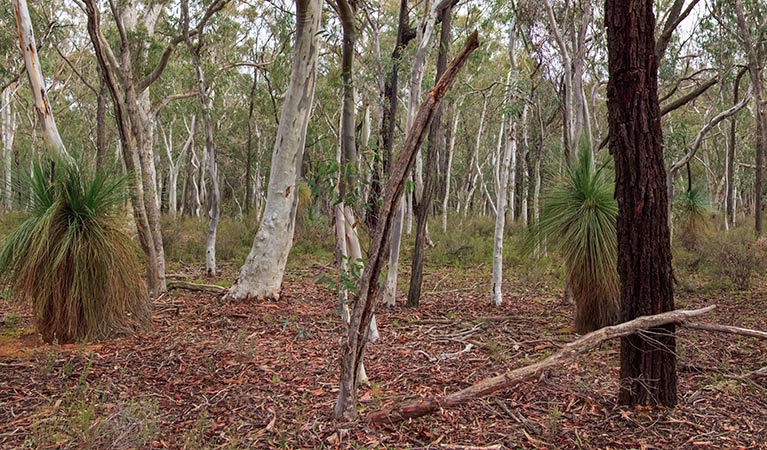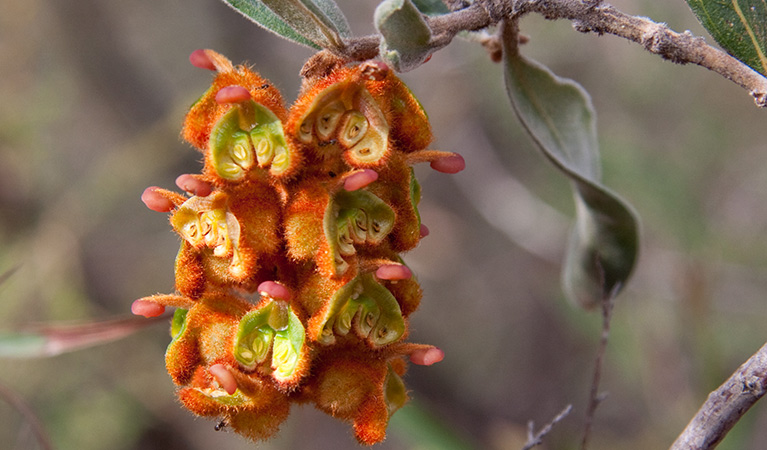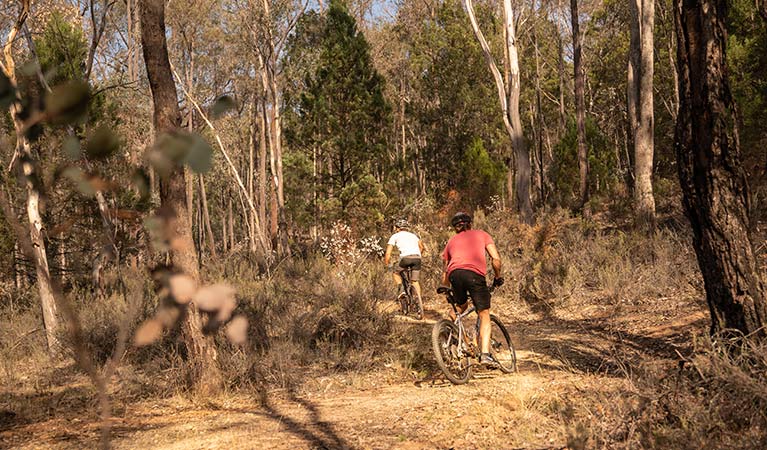Livingstone loop track
Livingstone National Park
Overview
Livingstone loop track is a great multi-use track you can enjoy while bushwalking, bird watching, mountain biking or horse riding near Wagga Wagga.
- Where
- Livingstone National Park in Murray-Riverina
- Distance
- 4.3km loop
- Time suggested
- 2-3 hr
- Grade
- Easy
- What to
bring - Hat, sunscreen, drinking water
- Please note
- The track is an easy 2hr ride or 3hr walk.
- As this is the only multi-use track in the region, please minimise your impact on the land by staying on the track.
- There is a Substantial risk of Unexploded Ordinances (UXO) within areas of Livingstone National Park. Please stay on the formed trails for your safety.
- Green Circle International Mountain Bicycling Association (IMBA) Classification for mountain biking
- Check the weather before you set out as the trail should not be used during wet weather
- Remember to take your binoculars if you want to birdwatch
Livingstone loop is a 10km multi-use track , perfect for enjoying some of the loveliest parts of Livingstone National Park. If you’re bush walking, bird watching, mountain biking or horse riding, this track takes you through open woodlands full of tall cypress pines, scribbly gums, pockets of xanthorrhoea (grass trees) and spectacular rusty spider flowers. In spring, areas are blanketed in gorgeous wildflowers, including yellow flowering kangaroo thorn and yellow clustered everlastings.
Visitors can complete Glider loop of 4.3 kilometres or Daisy loop of 5.7 kilometres, or combine the two loops for an extended ride of 10 kilometres.
As the only multi-use track in the region, it’s very popular. Members of the Wagga Wagga Wilderness Walkers and Wagga Wagga Mountain Bike Club frequently visit here. It is a great experience for families and anyone wanting a dose of nature and fresh air.
Birdwatchers should be sure to bring their binoculars; scarlet robins, brown tree creepers, speckled warblers and turquoise parrots are best spotted early morning or late afternoon.
Map

Map legend

Local alerts
For the latest updates on fires, closures and other alerts in this area, see https://uat.nswparks.cloud/things-to-do/cycling-trails/livingstone-loop-track/local-alerts
General enquiries
- National Parks Contact Centre
- 7am to 7pm daily
- 1300 072 757 (13000 PARKS) for the cost of a local call within Australia excluding mobiles
- parks.info@environment.nsw.gov.au
Park info
- in Livingstone National Park in the Murray-Riverina region
Livingstone National Park is always open but may have to close at times due to poor weather or fire danger
Visitor info
All the practical information you need to know about Livingstone loop track.
Maps and downloads
Learn more
Livingstone loop track is in Livingstone National Park. Here are just some of the reasons why this park is special:
Lands of plenty

Livingstone National Park is Wiradjuri Country. The land and all within it has great importance to local Aboriginal spirituality and culture - art, ceremonial sites and spiritual places are throughout this outstanding landscape. Many plants, such as grass trees and mugga ironbark, have been used to produce shields, medicine and boomerangs. Livingstone is covered by the Wagga Wagga Local Aboriginal Land Council, so when you're in this country, you're in a place where Aboriginal culture is integral to its past, present and future.
Pastoral historic heritage

Livingstone National Park was once pastoral holdings until the area was converted to a state forest in 1917. Continuous, though limited, mining occurred from 1872 to 1950, and again in the early 1980s. Early mining activity was for gold and, in later times, wolframite. Today, there is still evidence of trenches, mullock heaps, and mine shafts.
Wild about wildflowers and wildlife

During spring, you'll see an abundance of beautiful plants flowering in Livingstone. Bursts of purple Austral indigo interspersed with yellow kangaroo thorn, cream-coloured grass trees, and nodding blue lily (which is actually purple) form a kaleidoscope of vibrant colours. A population of Yass Daisy, a threatened species, occurs in Livingstone - the most south-westerly limit of its known range. Six distinctive forest ecosystems here make for a uniquely varied, interesting landscape. The park also contains a diverse range of native animals, including 5 amphibian species, 9 reptile species, 15 mammal species, and 185 species of birds. Many threatened species have been recorded here, and it's a sanctuary for swift, superb and turquoise parrots, barking owls, hooded robins, and diamond firetails.
- Livingstone loop track Livingstone loop track is a great multi-use track you can enjoy while bushwalking, bird watching, mountain biking or horse riding near Wagga Wagga.

